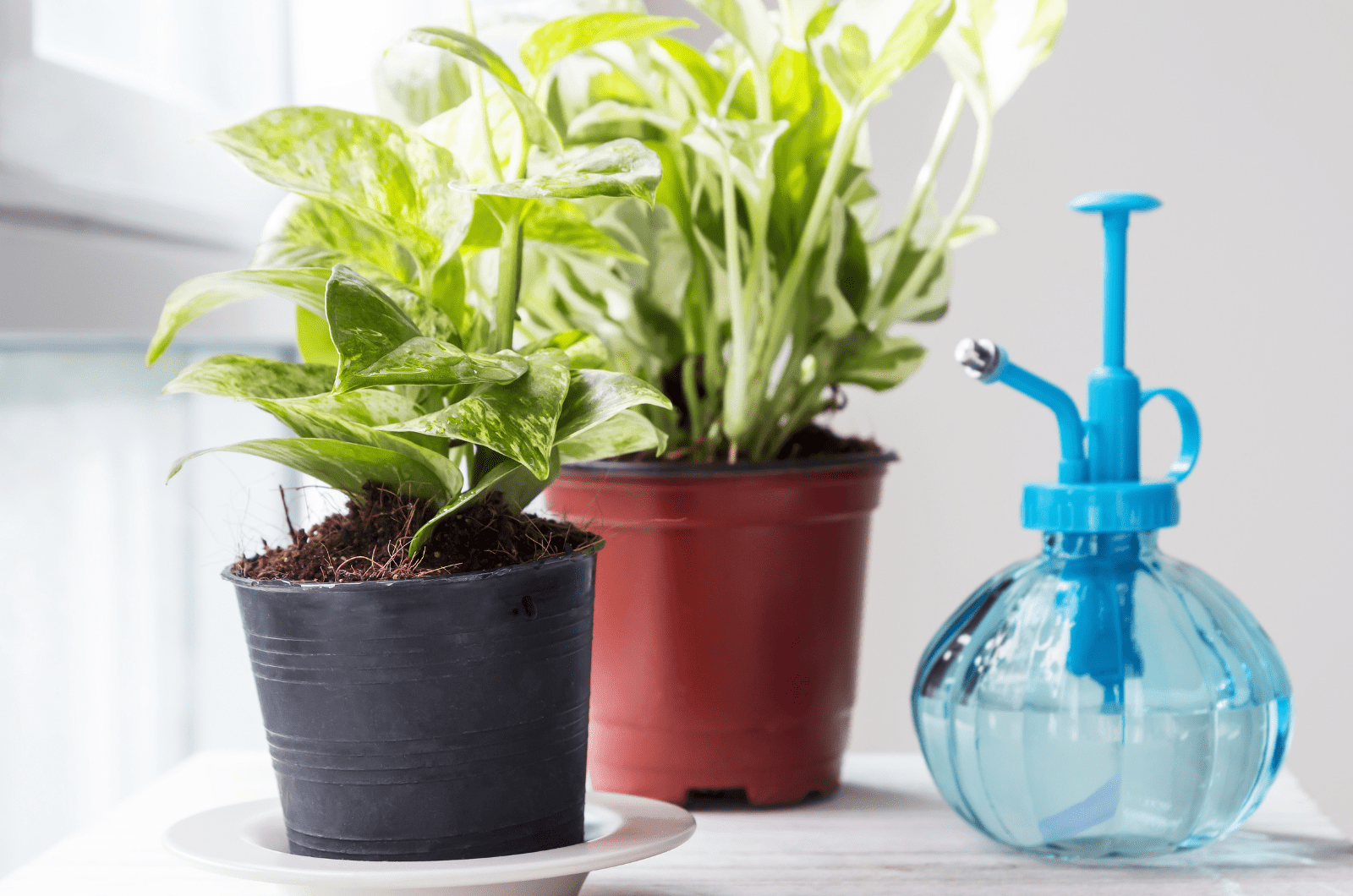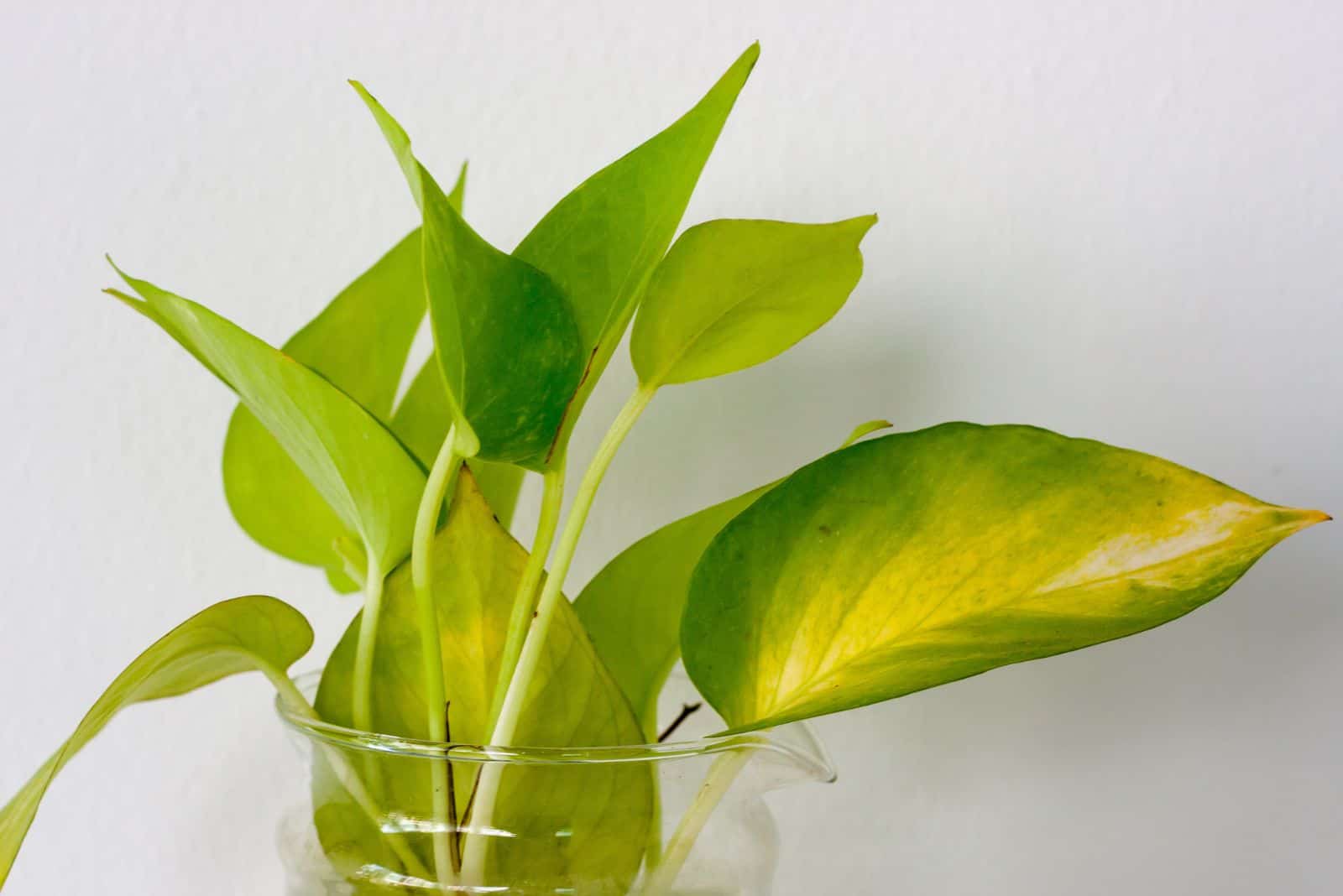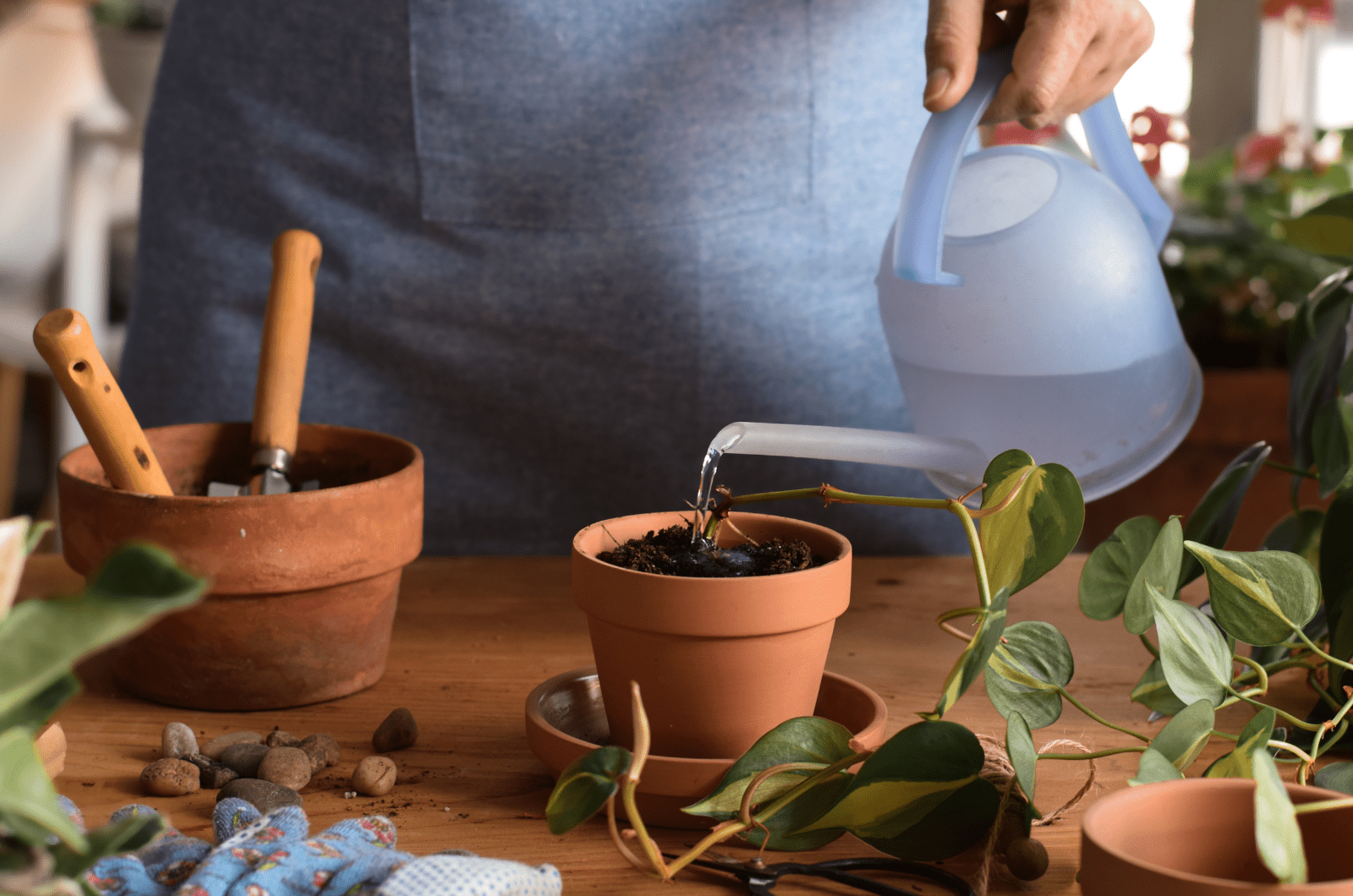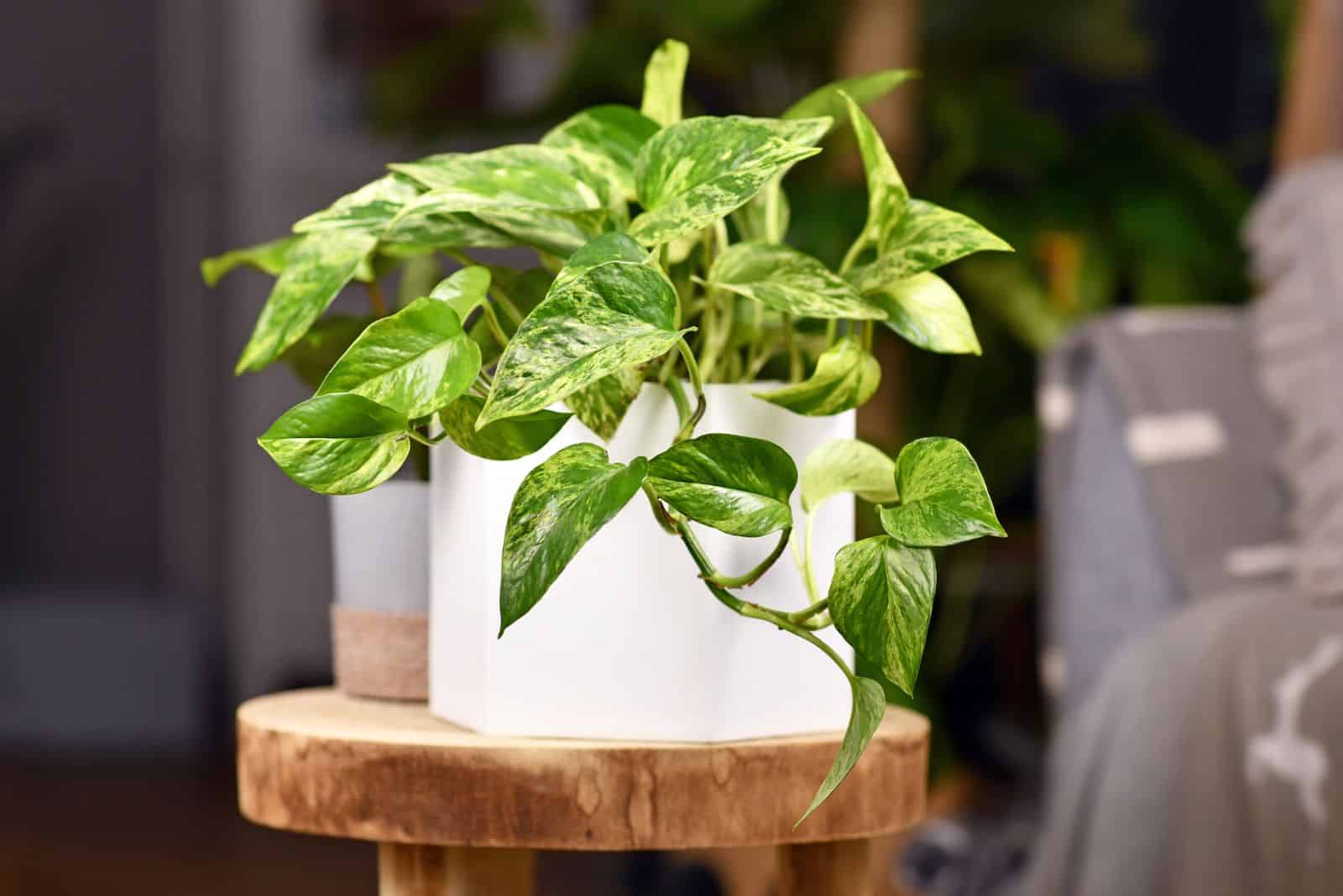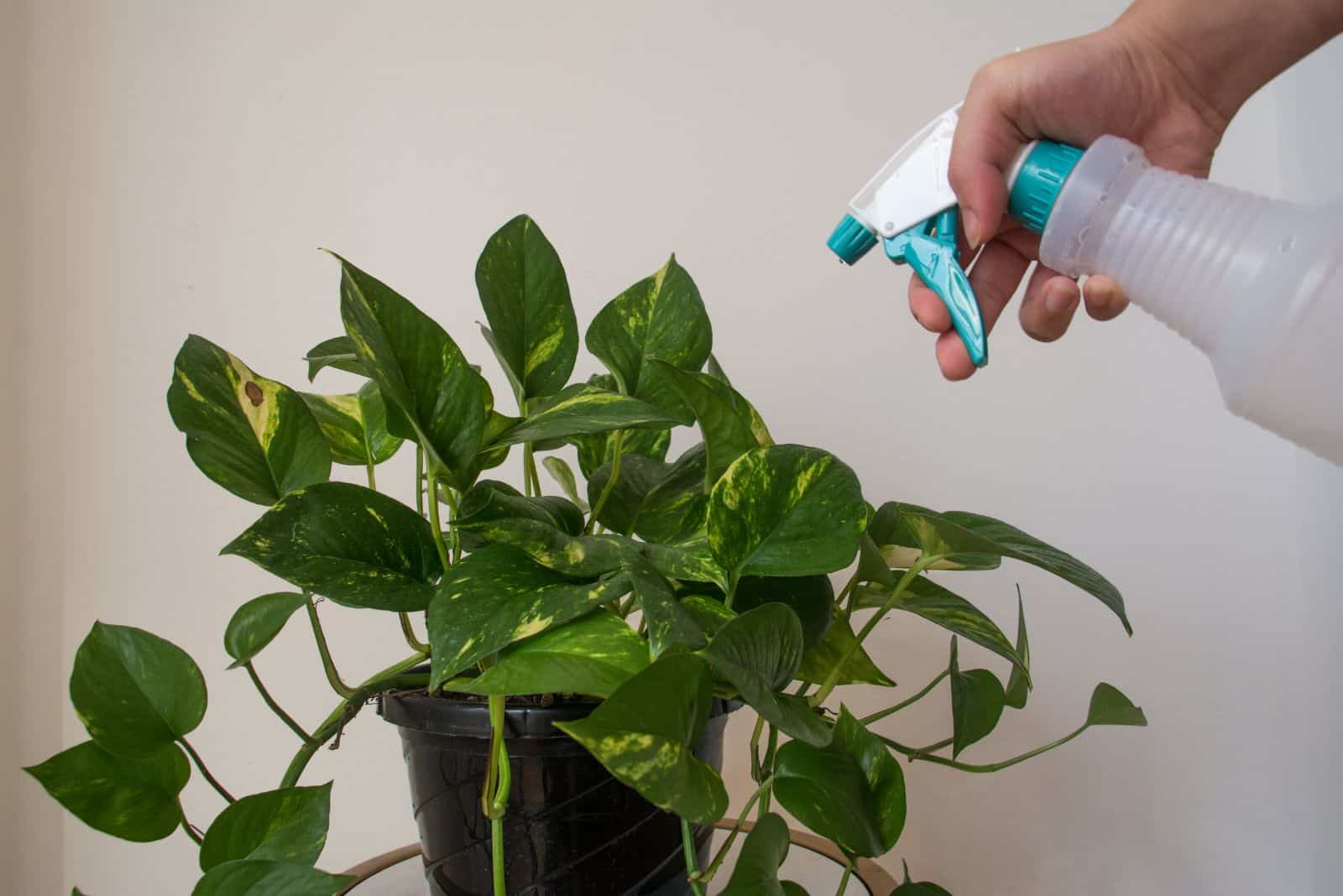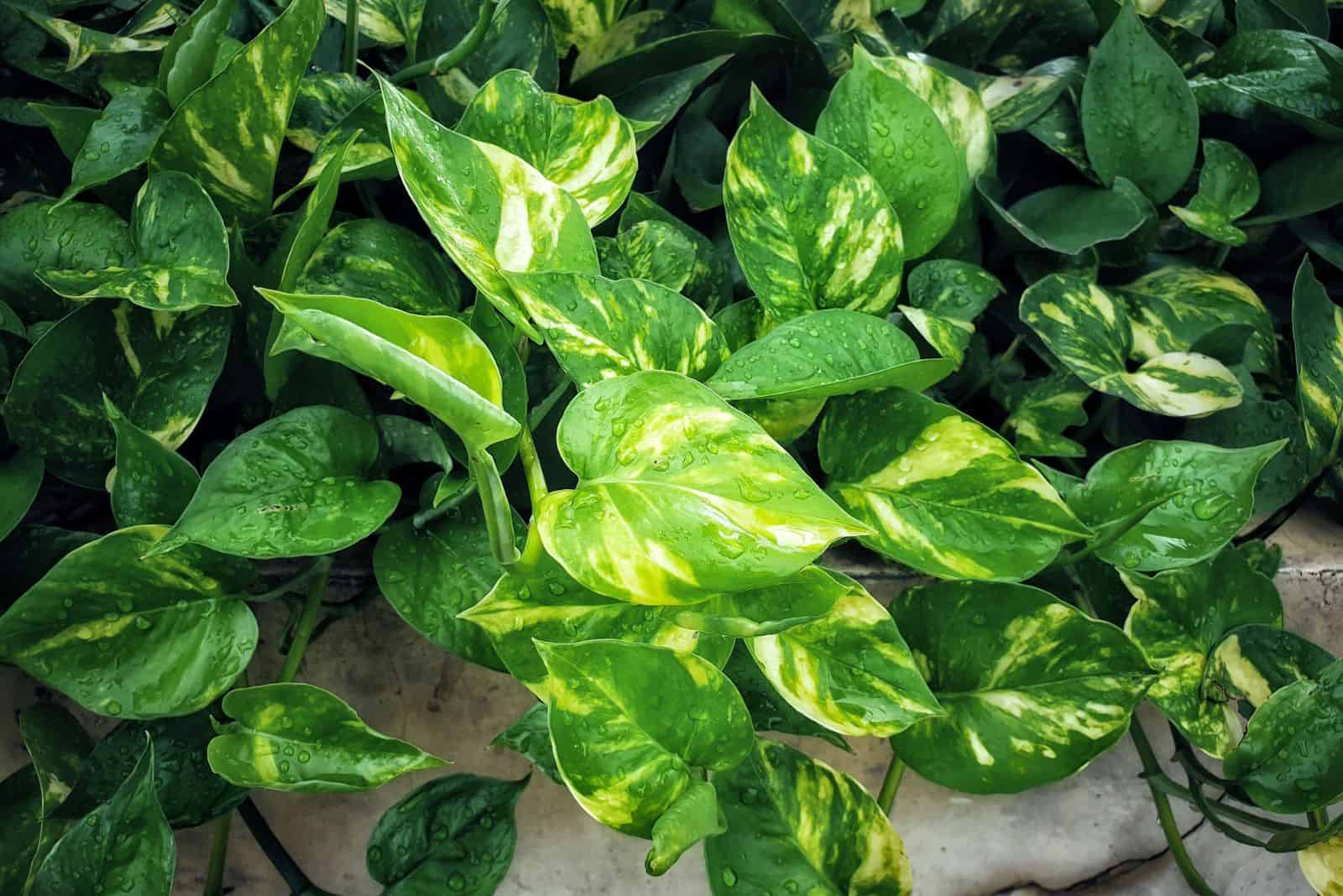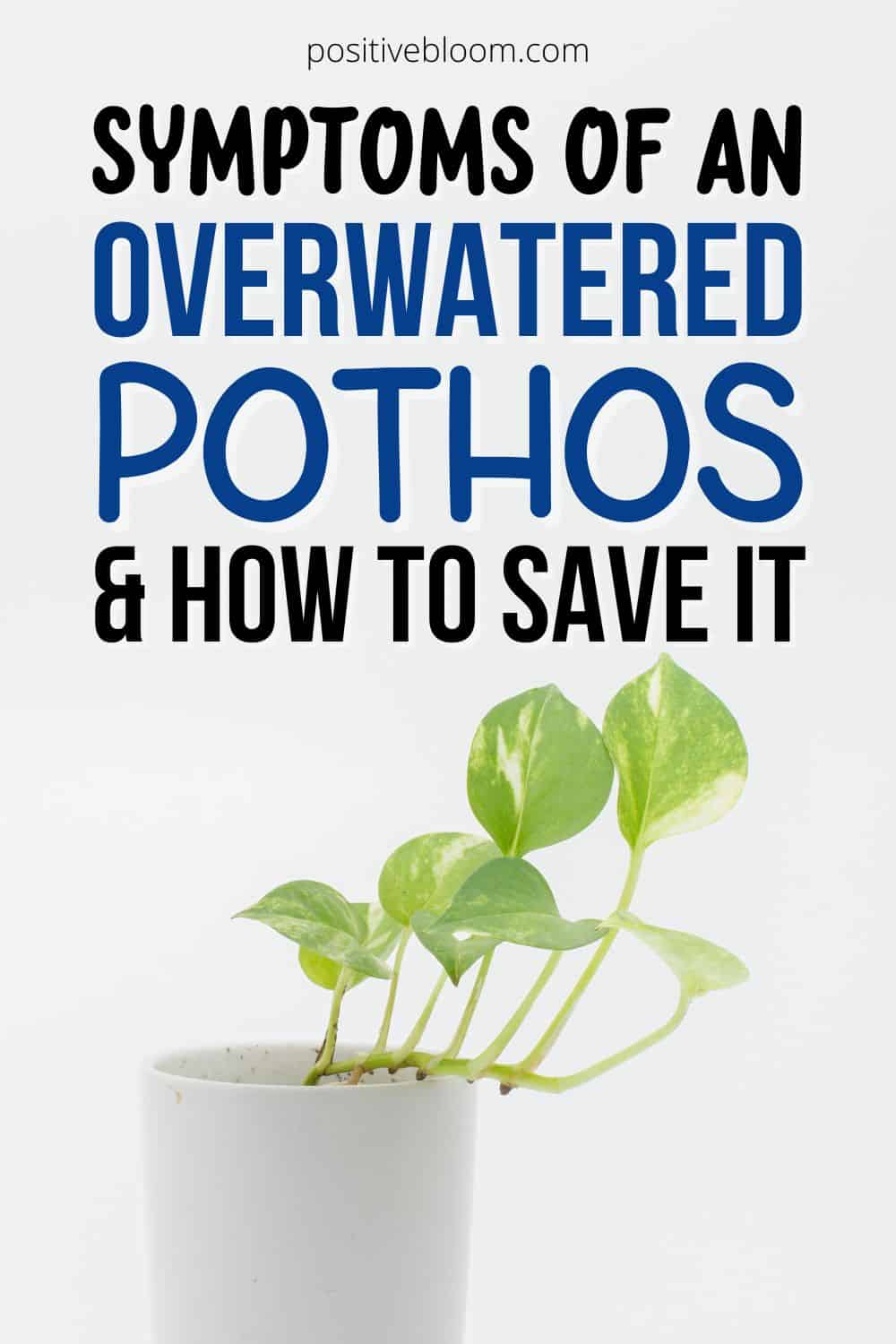It’s very easy to overwater houseplants, and it can cause serious damage.
The question is, why does this happen in the first place? You don’t overwater plants just by splashing them with water.
As well as using the incorrect watering method, you may also water too frequently or not provide adequate drainage.
Epipremnum aureum, more commonly known as pothos or devil’s Ivy, is a low-maintenance plant, which means it’s pretty hard to kill unless you overwater it.
That’s why it’s essential to learn the symptoms of an overwatered pothos and the severity of the damage. Knowing all this will make it easier to solve the issue and bring your pothos back to its old glory.
I have prepared everything you need to know so you can make your pothos healthy and thrive again!
Let’s dive straight in!
Symptoms Of An Overwatered Pothos
The common signs of an overwatered pothos plant include root rot, yellow leaves, brown spots on the leaves, moldy/mushy soil, wrinkled leaves, leaves curling or blisters, and the entire pothos plant wilting.
There are many symptoms of overwatering, but once you learn them you will be able to deal with the issue easily and prevent it from happening again.
Let’s get into details!
Root Rot
Root rot is a serious problem for any plant. Plants generally despise waterlogged soil, and only a couple of species grow well in it.
Pothos isn’t a plant that grows well in waterlogged soil, and time in overly wet soil even for a shorter period can cause irreparable damage.
Root rot is first on my list of symptoms because it’s the hardest to spot, and the roots are what suffer from the excess water in the soil first.
Many other issues are caused by unhealthy roots because in the plant world everything starts with the roots, and a healthy root system is crucial for new growth.
Pothos leaves and stems receive all the food necessary for their growth from the roots.
So, what causes rotting? The structure of the soil includes air spaces necessary for airflow. Although it may sound surprising, roots, just like humans, need oxygen to function properly.
Excess water gets into the air pockets and clogs them until it completely restricts the oxygen flow.
Consequently, the roots are without oxygen, suffocate, and rot.
As mentioned, spotting rot in the early stages is hard or even impossible. Still, some signs on or above the soil surface can help you determine if rotting roots are the case.
Yellow Leaves
Yellow leaves on pothos plants occur for many reasons. The age and position of the leaves will help you determine if overwatering has caused the yellowing.
Inspect the older leaves closest to the topsoil. Roots send food and water to pothos leaves, and the lower leaves should receive them first.
Of course, if the roots lose their function they can’t send anything, so the leaves turn yellow.
In botany, this process is known as leaf chlorosis and necrosis.
Brown Spots
Like with yellow leaves, there are many common reasons for brown spots on pothos leaves. Pests, low humidity, direct sunlight, and fungi may all be the causes of brown spots.
However, I highly recommend checking the moisture level of the plant’s soil first if you see these kinds of spots.
Why do brown spots occur? I already mentioned excess water and its impact if it’s present in the soil, but when plant cells are drowning in water they actually swell and blisters form as a result.
When blisters appear on the leaves of your pothos, they create brown lesions.
Scientifically speaking, your pothos is dealing with leaf edema, which usually occurs on the undersides of the leaves.
Moldy Soil
Moldy soil is a tell-tale sign of overwatering. If you notice that the topsoil is covered with a powdery substance, it is likely the result of fungi growth below the surface.
If you continue pouring water into already wet soil, you will be feeding the fungi and it will continue to spread.
Wrinkled Leaves
If you haven’t solved the issue of brown spots on the leaves, the affected surface of the leaves will start displaying wrinkles.
This affects the tips of the leaves in particular, and the appearance of the entire pothos plant.
Leaves Curling
There are also many possible causes for pothos leaves curling.
You may think that underwatering is the most common, but believe it or not an overwatered pothos can also display this symptom!
In both cases, the leaves dehydrate; if underwatering is the cause, the soil and pothos roots don’t have enough water to send to the leaves.
On the other hand, the pothos roots won’t function due to all the excess water, and when they are dead they can’t send water to the leaves.
The direction in which the leaves are curling can tell you if watering issues are the cause of the curling.
In the case of overwatering, pothos leaves will curl downwards.
The leaves attempt to reduce their surface area by curling as they want to store water and prevent transpiration.
Plants will fight their hardest to store water in case they’re affected by drought.
Pothos Wilting
Your devil’s Ivy plant will be on the verge of dying if it begins to wilt from too much water.
While you can stop wilting in underwatered pothos plants by providing them with enough water, you can’t with an overwatered Epipremnum aureum.
The amount of damage to the pothos roots has gotten so bad that they cannot satisfy the plant’s need for food and water.
Mushy Soil With An Unpleasant Smell
The smell of rot is seriously awful, but in this case it may be helpful because it’s a clear sign that something is wrong below the surface of the soil.
Look closely at the soil to see if you are dealing with an overwatered pothos. If it appears mushy and has an awful smell coming from it, there’s too much water in the soil.
Stagnant water is responsible for the foul odor, and your pothos needs further observation in this case.
Overwatered vs Underwatered Pothos
Now that you know the signs of an overwatered pothos, it’s time to take a look at the signs of an underwatered pothos.
It’s essential to know the difference because you don’t want to add more water to soggy soil. At the same time, you don’t want to drain an already dehydrated pothos.
The first sign you will notice when underwatering is the cause, is the color of the leaves. Just like overwatering, underwatering can cause the leaves to turn yellow.
However, if your pothos is lacking water, the leaves will also be crispy and start drooping.
If you leave your pothos plants without water for an extended period, they will display stunted growth, wither, and eventually die off.
How To Check If The Soil Is Receiving Too Much Or Too Little Water
If you are unsure what has caused the damage to your pothos, the best idea would be to check the moisture level in the soil.
There are a couple of ways to check if the soil either lacks or has too much water.
Let’s start with the easiest one – you only need your eyes for this method. Observe the color of the pothos soil and if the topsoil is darker you should delay watering and check again in the future.
Of course, you can’t rely on this method 100%, but it can help, especially if you have been growing plants for a while and have a good eye.
The second way – and many growers’ favorite – is sticking a finger in the plant’s soil. The longer you use this method, the more you’ll come to rely on it.
Insert your finger in the pothos soil (2-3 inches deep) and check if it is moist enough. This method works particularly well with smaller pots.
Another great method for checking the moisture level is by lifting the pot. Of course, this only works for smaller plants; trust me, you don’t want to try lifting mature fiddle leaf fig plants!
If your pothos pot is relatively lightweight, it’s time to water it.
However, none of these methods guarantee that your plant really lacks or has too much water.
The safest method is to purchase a moisture meter. This device will tell you the soil moisture content precisely.
How To Save Overwatered Pothos Plant
Now that you know the signs of both an overwatered and underwatered pothos, as well as how to check the moisture, it’s time to find out how to save the plant in the case of overwatering!
To save overwatered pothos plants, you’ll first need to estimate the level of the damage. You’ll then need to let your pothos drain, which includes delaying watering for an extended period. You should also remove your pothos from its pot and eliminate any rotten roots. Before repotting, you should also remove all damaged leaves.
Let’s get into details!
Check The Severity Of The Damage
This step is essential because there’s no point trying to save an already dead plant or, on the other hand, disturb the healthy roots.
If all the leaves, no matter their age and position, are limp and completely soft, yellow, or brown, the plant is wilting, and the soil is mushy, it may be too late for your pothos.
If your pothos still looks healthy, has green leaves, and is only showing two to three signs of overwatering, you can start reviving it.
Get Rid Of The Excess Water
If the soil is dark and mushy but your pothos isn’t displaying any other changes, you should check if the drainage holes are doing their job.
You can take a stick or anything else that fits in the drainage holes and poke them to check the soil condition at the bottom of the pot.
If you have recently watered your pothos and the drainage holes have caused the issue, the excess water should start coming out again.
Delay Watering
This is quite obvious, but still, I have to remind you to delay watering for a little while. Think of it as a glass full of water; you’ll get nothing by pouring more water into it except spilled water everywhere!
Place your pothos in bright indirect light, but never expose it to direct sun to dry the soil more quickly. You will only do more damage.
Your goal is to speed up evaporation. Remember that it takes time, so it’s better to wait for a little bit – it definitely won’t happen overnight.
Improve Aeration
Another thing you should do is improve aeration. In other words, you needt to promote airflow so the roots can breathe again.
Start digging! Gently make more holes in the soil; this technique will both improve and speed up drainage, and help the bottom part of the soil get some air.
Cut Off Damaged Leaves
Severely affected leaves don’t function, so leaving them on the plant isn’t a good idea.
Even though the leaves aren’t completely healthy, they will still take water from the roots and use food that the healthy leaves could consume.
It’s only a matter of time before these leaves will start rotting themselves. Search for yellow and brown leaves and remove them with a sanitized knife or a pair of scissors.
After you remove the affected or dead leaves, you should wait for a couple of days to see if there are any signs of improvement.
If the soil dries out and the yellowing stops, your pothos is healthy again!
Repot Your Pothos
You can revive your pothos by repotting no matter the cause of the issues. Repotting may help even in severe cases of damage – in this case, root rot due to overwatering.
Here’s how to repot your pothos:
1. Remove your pothos from its container. It may be tempting to pull your pothos out of its pot, but this will only damage the root ball and kill your plant. The best idea would be to tip the container to the side and help your pothos slide out. If necessary, use a knife to maneuver around the edges of the soil.
2. Get a NEW POT! Never use the old pot or you may contaminate the new soil. Add a layer of fresh soil to the bottom of the pot.
3. Inspect the pothos root system before you place it in the new pot. Your goal now is to remove all the damaged roots of the plant. Always use a sanitized knife for cutting and be careful not to damage the healthy roots.
4. Apply fungicide to the root system. Remember, you want your repotted pothos to be completely healthy.
5. Place your devil’s Ivy in the center of the new pot and add more soil until the pot is full.
6. Water your Epipremnum aureum after repotting.
How To Water Pothos Plants
Most problems suffered by indoor plants are caused by improper watering. We’ve seen what overwatering can do to your pothos, so now it’s time to learn about proper watering.
Let’s learn more!
Top Watering
Top watering is the most common watering method, and involves pouring the desired amount of water over the soil.
The biggest issue with this method is accidentally pouring water on the pothos plant leaves.
If you decide on this method you should use a watering can or something similar, just make sure it has quite a long snout.
Remember to deeply water your devil’s Ivy and then leave it until the excess water drains away.
Place your pothos in its original spot. Bear in mind that pothos plants grow best in bright indirect sunlight.
Bottom Watering
I use the bottom watering method for my pothos as it’s easier to avoid overwatering. To bottom water your pothos you’ll need a large container or sink.
Fill half of the container/sink with water and place the pothos in it.
The pothos roots will gradually absorb water until they receive enough.
Be careful – bottom watering may trick you into thinking you have watered your pothos entirely, but the middle of the soil may remain dry.
There is a solution to this; stick your finger in and check if the soil has enough moisture.
Water Quality
Although it’s easy to just use tap water for watering pothos soil, it should be your last option.
It is essential to avoid the salts that build up in tap water as they can damage pothos roots.
The best water for plants, including pothos, is filtered water or rainwater.
However, if you can’t get either of these two, leave tap water to sit overnight. This way, the harmful substances should evaporate and the water will be safer.
How Often To Water A Pothos
I wish I could tell you that the best time to water pothos is on Mondays at 7 p.m, but that’s sadly not the case!
Never rely on a fixed watering schedule – this applies to other plants as well.
This is because warmer temperatures, low humidity, and more direct light increase the speed of water evaporation from the potting soil.
Entirely dry soil is terrible for your pothos, so the best thing would be to check the soil before each watering. Of course, you’ll need to do this more often in the summer.
When it comes to pothos plants, the upper half of the soil should be dry before you water.
Best Time To Water
The main factor that influences when you should water is evaporation rate.
When you water your plants in the morning, especially potted plants, the water will evaporate gradually throughout the day.
The soil has enough moisture during the hottest parts of the day.
On the other hand, the evaporation rate decreases as the night approaches because temperatures are lower.
Therefore, you should water your pothos early in the morning to avoid overwatering.
Common Mistakes When Watering Devil’s Ivy
If you are a beginner grower wondering if pothos plants need drainage to grow healthily, I’m sure you now know the answer because you’ve learned how easy it is to overwater pothos.
The most common mistake when watering pothos is not ensuring good drainage. This involves choosing the right pot for your pothos, which must have drainage holes to help the soil get rid of excess water.
Another factor that plays an essential role in good drainage is the type of soil. Choosing an adequate potting mix should be your first goal when you first get your pothos.
No matter the type of soil you choose, I recommend adding some perlite to aid proper drainage.
Another common mistake is not checking your pothos regularly. This is the key to maintaining healthy plants as it helps you understand watering needs and spot pests or any other issues in time.
It may sound tempting to water pothos leaves to keep them clean and fresh, but you must avoid this practice as much as possible.
Your goal is to provide the roots with enough water because they are the ones that send both water and nutrients to the pothos leaves.
FAQs
Can an Overwatered pothos recover?
An overwatered pothos has a great chance of recovery. Of course, if the entire rootball is rotten and all the leaves are discolored, soft, and drooping, it may not be possible.
Inspect your pothos regularly, and if you notice any signs of overwatering you must react quickly. I’m sure your pothos will recover quickly with the tips from this article.
How long does it take for an overwatered plant to recover?
The time your pothos needs to recover mainly depends on the severity of the damage. After you remove the damaged leaves, drain the soil, and stop watering, you can expect your pothos to recover in about two weeks. You should notice new growth and the leaves will be green and shiny again.
However, if your pothos suffered more severe damage and you repotted it, it may take longer than two weeks. The roots need more time to recover and absorb water and nutrients properly.
If you follow the steps from this article and provide adequate care, your pothos will be happy and healthy again!
What is the best way to care for an overwatered pothos?
Start by choosing the best type of soil. You should aim for well-draining and porous soil because compact soil may prevent the roots from functioning properly.
Adding perlite, vermiculite, and peat moss is a great way to achieve all of the above.
Make sure the room where your pothos is growing has high humidity and temperatures ranging from 60 to 80 degrees Fahrenheit.
Avoid direct sun. Bright indirect sunlight is much better. Water your pothos when the upper half of the soil is dry.
Wrapping Up
Watering is an essential part of pothos care, but it doesn’t like too much water around its roots.
An overwatered pothos will display curling, wrinkling, yellow or brown leaves, blisters, and moldy or mushy soil. If your pothos starts wilting, you are dealing with a severe case of overwatering.
If you notice any of the signs above, remember that not everything is lost.
React quickly and save your pothos by using our tips.
Good luck and until next time!
Like this post? Share or pin it for later!

